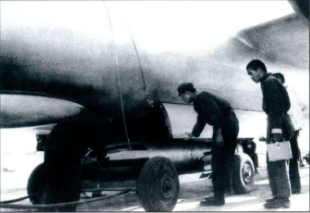-
Yes
-
No

Background
Spoiler
Some sources regard this variant as the “H-5B”, however, other sources state that there is no known designation.
In 1965, the PLANAF initiated the request to modify the H-5 aircraft in order to accommodate torpedoes. The design for this modification commenced in 1966. The specified requirements included the capability to carry either 3 torpedoes or 2 larger torpedoes, which could be externally mounted on the aircraft. Additionally, the aircraft would optionally also carry 2 sets of auxiliary fuel tanks in the bomb bay. On November 30, 1969, Wang Wenying successfully conducted the first flight of the H-5 torpedo type.
By 1980, a total of 35 aircraft had been delivered to the Navy. Furthermore, over 100 H–5 aircraft have been modified for the troops, and their response has been positive.
The H-5 torpedo type is equipped with both ordinary direct-sail torpedoes and Yu-2 air-dropped rocket-powered torpedoes.
The aircraft has since been retired.
Technical Data
Specifications
Crew - 1 Pilot, 1 Gunner, 1 bombardier.
Length - 16.768 m
Height - 6.2 m
Wingspan - 21.45 m
Empty Weight - 12,890 kg
Max Takeoff Weight - 21,200 kg
Engine - 2 x WP-5 Turbojet engines (2,678 kgf)
Max Speed - 902 km/h at 4,500 m
Range - 2,500 km
Armament
1 x 23mm NR-23 cannon.
1 x 2 x 23mm NR-23 cannons in tail turret.
3 x 1,000 kg Torpedo’s
2 x Yu-2 Torpedo’s (Outboard Pylons)
12 x 100 kg FAB-100M-43 bombs.
8 x 250 kg FAB-250M-46 bombs.
4 x 500 kg FAB-500M-46 bombs.
1 x 1,500 kg FAB-1500M-46 bomb.
1 x 3,000 kg FAB-3000M-46 bomb.
Images
Sources
Spoiler
(Book) Encyclopedia of Chinese Aircraft, Vol.3 - Page 165 - 166
(Book) Dragons Wings Chinese Fighter and Bomber Aircraft Development - Page 187


